
Forest Solutions
Confidence Experience Knowledge
Aiding Recovery, Assisting Restoration, and Building Resilience for Australia's Temperate Forests
01/02/2012 - 2011; a big year for Forest Solutions. |
  
|
 During 2011, Forest Solutions reached that important business benchmark of continuous operation for 3 years, indicating a successful business establishment. “Starting a business in the field of native forest silviculture, bedding it down, then growing it (alongside the trees!) has been a major challenge, but we are really pleased to have met our first major target – to be still operating after three years!”, says Director Owen Bassett. Forest Solutions has been involved with major projects for state government and private industry, and is currently negotiating to assist new clients, including CMAs. We now employ six staff and have partnerships with various other organisations, resulting in significant capacity. A highlight during 2011 has been to assist the state government during their development of new seed management policies, procedures and a new seed processing facility at Laverton North. This significant development will increase the government’s capacity for rapid response forest recovery following major bushfires in Victoria.
During 2011, Forest Solutions reached that important business benchmark of continuous operation for 3 years, indicating a successful business establishment. “Starting a business in the field of native forest silviculture, bedding it down, then growing it (alongside the trees!) has been a major challenge, but we are really pleased to have met our first major target – to be still operating after three years!”, says Director Owen Bassett. Forest Solutions has been involved with major projects for state government and private industry, and is currently negotiating to assist new clients, including CMAs. We now employ six staff and have partnerships with various other organisations, resulting in significant capacity. A highlight during 2011 has been to assist the state government during their development of new seed management policies, procedures and a new seed processing facility at Laverton North. This significant development will increase the government’s capacity for rapid response forest recovery following major bushfires in Victoria.
04/03/2011 – “Oh, what a season”, eucalypt forests repair. |
  
|
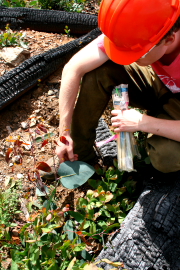 Victorian eucalypt forests have experienced one of their best seasons of growth and establishment in over a decade. Rainfall totals of over 300% of long term averages have fallen across the Great Dividing Range, bringing perfect conditions for regrowth of young eucalypts - following both bushfire and timber harvesting. Forest Solutions has monitored the progress of two major forest rehabilitation operations since early 2010; the VicForests Connors salvage operation, and the operational regeneration of harvested coupes in East Gippsland. New germinations of eucalypt seed have continued throughout summer, "....a very unusual situation", reports Director Owen Bassett. Coupled with the skill and excellent management applied by VicForests' regeneration team, the successful regeneration of these salvage coupes is now virtually assured. Understorey species are also returning in diverse numbers, and at densities in-line with EVC benchmarks. The monitoring results indicate the powerful resilience of Victoria's native forests to such disturbances. "We do have the skills and knowledge to sustainably use and regenerate native forests, including the capacity to assist forest recovery following bushfires", Owen stated.
Victorian eucalypt forests have experienced one of their best seasons of growth and establishment in over a decade. Rainfall totals of over 300% of long term averages have fallen across the Great Dividing Range, bringing perfect conditions for regrowth of young eucalypts - following both bushfire and timber harvesting. Forest Solutions has monitored the progress of two major forest rehabilitation operations since early 2010; the VicForests Connors salvage operation, and the operational regeneration of harvested coupes in East Gippsland. New germinations of eucalypt seed have continued throughout summer, "....a very unusual situation", reports Director Owen Bassett. Coupled with the skill and excellent management applied by VicForests' regeneration team, the successful regeneration of these salvage coupes is now virtually assured. Understorey species are also returning in diverse numbers, and at densities in-line with EVC benchmarks. The monitoring results indicate the powerful resilience of Victoria's native forests to such disturbances. "We do have the skills and knowledge to sustainably use and regenerate native forests, including the capacity to assist forest recovery following bushfires", Owen stated.
15/02/2011 – Face-lift for Guideline. |
  
|
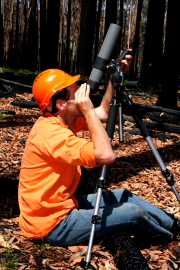 Forest Solutions has been chosen by DSE (via tender) to undertake a review of their guideline "Seedcrop Monitoring and Assessment". This guideline is one a series known as the Native Forest Silviculture Guideline (NFSG) series, and was the very first guideline originally produced by DSE (then NRE) in 1993 (NFSG No. 1). The guidelines provide forest managers with the practical knowledge and techniques to apply sustainable silviculture to Victoria's native state forests. Eucalypt seed is critical to forest recovery and regeneration following bushfires and other disturbances such as timber harvesting. Finding the seed resources and being able to assess its quality and abundance prior to seed collection is critical for cost-effective seed management. Since 1993 there have been many new developments, and staff at Forest Solutions have been central to this development - alongside DSE and VicForests. The new revised version of "NFSG No. 1" will reflect these significant developments, and increase our capacity to better manage native forests.
Forest Solutions has been chosen by DSE (via tender) to undertake a review of their guideline "Seedcrop Monitoring and Assessment". This guideline is one a series known as the Native Forest Silviculture Guideline (NFSG) series, and was the very first guideline originally produced by DSE (then NRE) in 1993 (NFSG No. 1). The guidelines provide forest managers with the practical knowledge and techniques to apply sustainable silviculture to Victoria's native state forests. Eucalypt seed is critical to forest recovery and regeneration following bushfires and other disturbances such as timber harvesting. Finding the seed resources and being able to assess its quality and abundance prior to seed collection is critical for cost-effective seed management. Since 1993 there have been many new developments, and staff at Forest Solutions have been central to this development - alongside DSE and VicForests. The new revised version of "NFSG No. 1" will reflect these significant developments, and increase our capacity to better manage native forests.
25/11/2010 – Ecological Thinning for biodiversity |
  
|
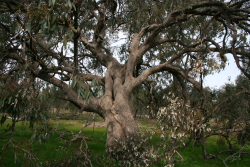 Box-Ironbark forests are a very special habitat that is particularly under threat in Victoria. No or little undisturbed Box-Ironbark remains today, and Trust For Nature (TFN) is on a mission to enhance the biodiversity of as many privately owned forests as possible. They achieve this through a system of conservation covenants with willing landowners. Many Box-Ironbark forests are today overstocked with regrowth following multiple disturbances. Thinning that regrowth has the potential to restore growth rates and woodland forest structures that support a more complex and heterogeneous biodiversity. Thinning also increases woody debris, which enhances forest-floor habitats.
Box-Ironbark forests are a very special habitat that is particularly under threat in Victoria. No or little undisturbed Box-Ironbark remains today, and Trust For Nature (TFN) is on a mission to enhance the biodiversity of as many privately owned forests as possible. They achieve this through a system of conservation covenants with willing landowners. Many Box-Ironbark forests are today overstocked with regrowth following multiple disturbances. Thinning that regrowth has the potential to restore growth rates and woodland forest structures that support a more complex and heterogeneous biodiversity. Thinning also increases woody debris, which enhances forest-floor habitats.
22/10/2010 – Eucalypts begin their spring germination |
  
|
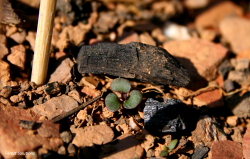 Eucalypts have begun their Spring germination in Victoria's state forests. And the recent drought breaking rains have assisted this process. It is hard to believe, but Victoria's iconic Alpine Ash forests, which stand typically at 40-60 meters tall, and can grow to 80+ meters, start their life at only 5 mm tall!
Eucalypts have begun their Spring germination in Victoria's state forests. And the recent drought breaking rains have assisted this process. It is hard to believe, but Victoria's iconic Alpine Ash forests, which stand typically at 40-60 meters tall, and can grow to 80+ meters, start their life at only 5 mm tall!
Forest Solutions has begun monitoring eucalypt germination for VicForests, the government owned enterprise responsible for the harvesting and sale of timber from Victoria's native forests. VicForests regenerates all area harvested, handing back these areas into DSE stewardship following their establishment. Monitoring their progress is vital, and Forest Solutions is watching over the progress of a sample of individuals across Gippsland for the first 12 months of their life. Collected data will assist VicForests to ensure these harvested areas are rehabilitated to the required standards.
Regeneration is the final, mandatory step in the cyclic process of utilising Victoria's unique and beautiful timbers.
16/10/2010 – Forest Solutions joins in the celebrations |
  
|
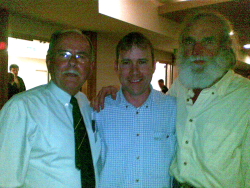 Melbourne University recently celebrated 100 years of forestry education at their Centenary of Forestry Education. And Forest Solutions attended in recognition of the University's role in educating and developing many of the skills that are used today when managing Victoria's native forests. Forest Solutions Director, Owen Bassett, attended 'The Future of Forestry and Forest Science Conference' in late September and reports, "Never before has the importance of social sciences been so well represented at such a conference - usually focused more on the science of forests. Foresters today are becoming more aware of the need to connect people with forests and the management of them."
Melbourne University recently celebrated 100 years of forestry education at their Centenary of Forestry Education. And Forest Solutions attended in recognition of the University's role in educating and developing many of the skills that are used today when managing Victoria's native forests. Forest Solutions Director, Owen Bassett, attended 'The Future of Forestry and Forest Science Conference' in late September and reports, "Never before has the importance of social sciences been so well represented at such a conference - usually focused more on the science of forests. Foresters today are becoming more aware of the need to connect people with forests and the management of them."
Celebrations peaked at the Centenary dinner, which took place at the Novotel Forest Resort in Creswick. Melbourne University's School of Forestry at Creswick has been educating Foresters now for over 100 years, and today offers the increasingly popular Master of Forest Ecosystem Science.
18/08/2010 – Flowering and seed development in eucalypts. |
  
|
 The 2010 forecast for eucalypt flowering and seed has just been released by Forest Solutions for the Central Highlands of Victoria. VicForests and DSE funded the project and will utilise the outcomes to ensure effective seed management in State forests.
The 2010 forecast for eucalypt flowering and seed has just been released by Forest Solutions for the Central Highlands of Victoria. VicForests and DSE funded the project and will utilise the outcomes to ensure effective seed management in State forests.
Using an extensive network of monitoring sites throughout mountain forests in the Highlands, floral components were collected, analysed, and the data modelled to produce predictions about when each eucalypt species will flower, or produce seed up until 2014. Light aircraft was also used to locate flowering in the landscape, indicating where future seed could be collected.
The Director of Forest Solutions said, "Knowing the natural cycle of these forest events will also assist with forest recovery following future bushfires. Seed is the principal requirement for regeneration in Ash forests".
12/07/2010 – Site preparation investigations |
  
|

In the early 2000s, the Department of Sustainability and Environment (DSE) aimed to investigate alternative techniques designed to produce improved regeneration outcomes following timber harvesting; one of these was the preparation of a receptive seedbed prior to harvesting, rather than after harvesting (the usual process).
DSE commissioned the Department of Forest and Ecosystem Science at Melbourne University to undertake the research, and Forest Solutions has assisted with the finalisation of reporting and interpretation of operational implications. The findings of this project will lead to additional options for site preparation during forest regeneration.
A DSE Officer is pictured here standing in 10 year old eucalypt regrowth which has established following gap selection.
29/06/2010 - Revision of a State Government Planting Guideline |
  
|
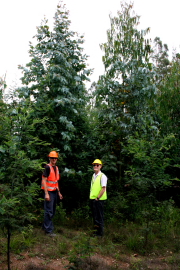 DSE has developed a comprehensive series of silvicultural guidelines called Native Forest Silviculture Guidelines. They provide the guiding knowledge and principles for silvicultural operations in Victoria’s native State forests. On contract to DSE’s Land and Fire Management Division, Forest Solutions has just undertaken the first complete revision of one of the 17 Guidelines - NFSG No. 9 – Eucalypt Planting.
DSE has developed a comprehensive series of silvicultural guidelines called Native Forest Silviculture Guidelines. They provide the guiding knowledge and principles for silvicultural operations in Victoria’s native State forests. On contract to DSE’s Land and Fire Management Division, Forest Solutions has just undertaken the first complete revision of one of the 17 Guidelines - NFSG No. 9 – Eucalypt Planting.
Part of the revision involved reviewing recent planting operations. Forest Solutions accordingly visited Hancock Victorian Plantations (HVP) on behalf of DSE to learn the latest thinking on planting, HVP being one of Victoria’s premier planting organisations.
The result has been a fully revised NFSG No. 9 with significant improvements, including new techniques for fertilisation, monitoring, and supervision in the field. DSE plan to release the revised Guideline later in 2010.
22/06/2010 – Cores & Links at HVP |
  
|
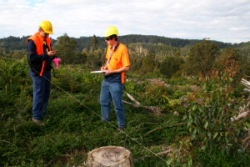 Forest Solutions has just finalised the development of an assessment procedure for HVP. The procedure assesses the density and stocking of eucalypts and understorey vegetation for three EVCs common to the Strzelecki Range in South Gippsland. HVP and DSE have signed a formal agreement for the formation of a special 8,600 ha Strzelecki reserve, known as "Cores & Links". The reserve contributes to a strategic linear link of habitat and important EVC communities throughout HVPs area of operation in the Strzelecki Range.
Forest Solutions has just finalised the development of an assessment procedure for HVP. The procedure assesses the density and stocking of eucalypts and understorey vegetation for three EVCs common to the Strzelecki Range in South Gippsland. HVP and DSE have signed a formal agreement for the formation of a special 8,600 ha Strzelecki reserve, known as "Cores & Links". The reserve contributes to a strategic linear link of habitat and important EVC communities throughout HVPs area of operation in the Strzelecki Range.
Part of that agreement allows HVP to first harvest some plantation Mountain Ash, planted in the 1960's, from about 1,500 ha of the Reserve. HVP will regenerate this area to an agreed Regeneration Standard. The independent procedure developed by Forest Solutions assesses the success of HVP regeneration operations, and is the tool for HVP to demonstrate compliance. Forest Solutions has also trained a local Contractor, Hazelwood Forestry, to undertake the assessments, and will assist HVP with the analysis, reporting and ongoing negotiations with DSE.
15/04/2010 – Aerial flowering assessments completed for 2009-10 |
  
|
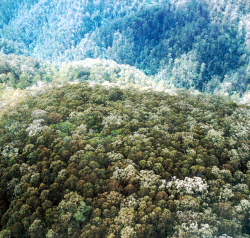 The aerial flowering assessments which begun 8 months ago have now been completed for 2009/10. Five commercial eucalypt species in Eastern Victoria have been assessed and the geographic location of flowering crops mapped using GPS technology. VicForests and the Department of Sustainability and Environment funded the program and will use the data to locate future seedcrops in the Victorian Alps. These seedcrops could be collected and used to assist forest recovery and rehabilitation operations.
The aerial flowering assessments which begun 8 months ago have now been completed for 2009/10. Five commercial eucalypt species in Eastern Victoria have been assessed and the geographic location of flowering crops mapped using GPS technology. VicForests and the Department of Sustainability and Environment funded the program and will use the data to locate future seedcrops in the Victorian Alps. These seedcrops could be collected and used to assist forest recovery and rehabilitation operations.
Forest Solutions will also use the data for its next annual flower and seed forecast - due in mid-2010. Forest Solutions can forecast seedcrops up to 3 years in advance, proving to be an invaluable management tool for forest management. Flowering of high elevation Mountain Ash (Eucalyptus regnans) is now also recognised as a potential indicator for the impacts of climate change on forests.
30/03/2010 – Forest Solutions walks for MND |
  
|
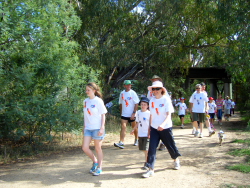 The recent passing of local Benalla identity Mr. Michael Rodger ended a long struggle for him with Motor Neuron Disease (MND). Michael was a much-loved member of our community, teaching our children Cricket and modelling caring leadership for us all.
The recent passing of local Benalla identity Mr. Michael Rodger ended a long struggle for him with Motor Neuron Disease (MND). Michael was a much-loved member of our community, teaching our children Cricket and modelling caring leadership for us all.
Prior to his passing, Forest Solutions staff were inspired to participate in the 2010 Act to D-Feet MND community walk held in Benalla on 28 February. Over 1,000 people attended. Michael himself briefly attended, and his family were involved in all the fun activities of the day. The Benalla community raised in the vicinity of $150,000 for research to combat MND, increasing its generosity from the 2009 Walk. Forest Solutions provided corporate sponsorship and individuals contributed through walk participation. Michael will never be forgotten.
15/03/2010 – Review of Central Highlands silviculture |
  
|
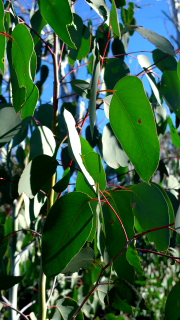 Forest Solutions has been consulted by VicForests to undertake its Annual District Silviculture Review (ADSR) for north Central Highlands in 2006/07 and 2007/08. VicForests harvested over 1,000 ha of native forest in NE Victoria over the period reviewed, and it is their legal responsibility and stated mission of sustainability to regenerate harvested areas using proven silvicultural techniques. However, every season is different, and forests vary in structure between localities; both often dictating innovative silvicultural strategies. VicForests does this very well.
Forest Solutions has been consulted by VicForests to undertake its Annual District Silviculture Review (ADSR) for north Central Highlands in 2006/07 and 2007/08. VicForests harvested over 1,000 ha of native forest in NE Victoria over the period reviewed, and it is their legal responsibility and stated mission of sustainability to regenerate harvested areas using proven silvicultural techniques. However, every season is different, and forests vary in structure between localities; both often dictating innovative silvicultural strategies. VicForests does this very well.
Forests Solutions has assisted VicForests by reviewing their strategies, observing what worked and what could be improved, and supporting their ongoing review-and-improvement processes. Such a commitment to improvement has assured that VicForests constantly increases their regeneration success and helps maintain their Australian Forestry Standard certification.
The ADSR report recognises the performance of VicForests throughout the period of recent, long-term drought, only just ending in 2009. It also provided specific technical and scientific advice regarding systems and processes required to improve the management of such complex ecosystems.
18/01/2010 – 2009 forecast for eucalypt flower and seed |
  
|
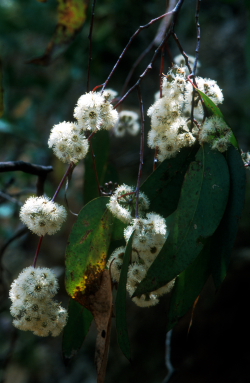 "A decline in flowering and seed production" until 2013 - that is the trend for flowering and seed production in the two mountain eucalypt species, Alpine Ash and Mountain Ash in the Central Highlands. Forest Solutions has used 14 years of continuous flowering data, collected since 1995 and up until the 2008/09 season. This forecast supports the need for long term storage of larger quantities of seed for forest recovery following bushfires.
"A decline in flowering and seed production" until 2013 - that is the trend for flowering and seed production in the two mountain eucalypt species, Alpine Ash and Mountain Ash in the Central Highlands. Forest Solutions has used 14 years of continuous flowering data, collected since 1995 and up until the 2008/09 season. This forecast supports the need for long term storage of larger quantities of seed for forest recovery following bushfires.
Forest Solutions has also demonstrated a link between drought and the absence of flowering in high elevation mountain ash - although the cumulative annual affects of the 1997-2009 drought is considered to affect flowering in Alpine Ash as well. Mountain populations could provide a strong vulnerability indicator for climate change via their flowering periodicity. Detailed time series and regression analysis of floral component data were used in conjunction with wide-spread aerial assessments of flowering distributions. Contact our Director, Owen Bassett, for more details.
15/01/2010 - Assisting regrowth after salvage |
  
|
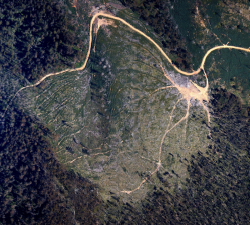 Following the 2006/06 bushfires in Victoria, thousands of hectares of Alpine Ash (Eucalyptus delegatensis) were killed. Ash species are intolerant of fire, and in general require stand-replacing disturbance for continuance of the species. Put simply, fires kill Ash, their seed is shed, and new life begins via "self-regeneration". However, at the time of the 2006/07 fires there was little seed in Alpine Ash - thought to be caused by the cumulative effects of long-term drought in Victoria.
Following the 2006/06 bushfires in Victoria, thousands of hectares of Alpine Ash (Eucalyptus delegatensis) were killed. Ash species are intolerant of fire, and in general require stand-replacing disturbance for continuance of the species. Put simply, fires kill Ash, their seed is shed, and new life begins via "self-regeneration". However, at the time of the 2006/07 fires there was little seed in Alpine Ash - thought to be caused by the cumulative effects of long-term drought in Victoria.
VicForests has the authority to salvage killed Ash timber from limited areas before it degrades and falls, and self regeneration following the fire is usually adequate to regenerate these areas. But this proved difficult in 2006/07 due to the lack of natural seed.
After harvesting, Forest Solutions provided VicForests with early regeneration planning assistance by the site characterisation of vegetation mosaics using API. Flown at 10,000 feet, Forest Solutions acquired images from which vegetation and indicators of eucalypt stocking were assessed. This information will assist identification of appropriate silvicultural strategies, allow stratified sampling for monitoring, and provide the basis for accurate review of regeneration outcomes at project completion.
11/11/2009 - New post-fire forest recovery guideline |
  
|
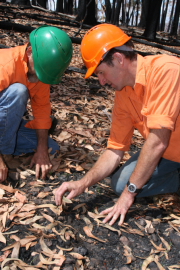 During his DSE experience following the 2003 bushfires in Victoria, Owen Bassett developed what he calls “rapid response” techniques and refined them during his 2006/07 Great Divide Fire work for VicForests. Following the 2009 Black Saturday bushfires, he was contracted by DSE to lead aspects of forest monitoring and recovery.
During his DSE experience following the 2003 bushfires in Victoria, Owen Bassett developed what he calls “rapid response” techniques and refined them during his 2006/07 Great Divide Fire work for VicForests. Following the 2009 Black Saturday bushfires, he was contracted by DSE to lead aspects of forest monitoring and recovery.
As part of Forest Solutions’ brief, Owen also joined the DSE team developing the new Native Forest Silviculture Guideline (NFSG) for forest recovery following bushfire. Owen’s “rapid response” techniques form an important component of the guideline, which covers procedures for the assessment of fire scorch intensity (canopy damage), the forest’s capacity to self regenerate, identifying damaged areas requiring rehabilitation, seed supply considerations for recovery, and site rehabilitation techniques. Owen is a co-author of NFSG #17, which is available from Information Victoria and also on the DSE website.
27/10/2009 - Forest Solutions assists DSE with Backlog regeneration |
  
|
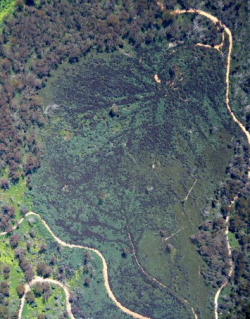 The Department of Sustainability and Environment (DSE) remains responsible for the regeneration of areas of State forest harvested prior to August 2004, after which VicForests took responsibility for this in Eastern Victoria. Prior to 2004 DSE had a commendable record of regeneration success, with 82% to 91% of area satisfactorily stocked (at the first attempt) since 1990. However, a small annual area of unregenerated forest has left DSE with a significant accumulated "backlog" requiring rehabilitation.
The Department of Sustainability and Environment (DSE) remains responsible for the regeneration of areas of State forest harvested prior to August 2004, after which VicForests took responsibility for this in Eastern Victoria. Prior to 2004 DSE had a commendable record of regeneration success, with 82% to 91% of area satisfactorily stocked (at the first attempt) since 1990. However, a small annual area of unregenerated forest has left DSE with a significant accumulated "backlog" requiring rehabilitation.
To help assess the current stocking status of such coupes in North East Victoria, Forest Solutions has used low-cost aerial photography and specialist photo interpretation. Outcomes were very positive, indicating that 85% of the assessed area is already regenerated to a minimum standard. Forest Solutions believes this form of remote assessment could be developed and used into the future, resulting in cost savings and lower OH&S risk compared with ground surveys.
01/10/2009 - 2010 aerial flowering assessments begin |
  
|
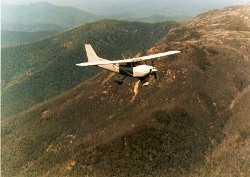 Each year, Forest Solutions undertakes a series of aerial flowering assessments in the mountains of eastern Victoria. These are undertaken using a Cessna 172 Hawk XP, and flown along mountain contours at various elevations mapping forest stands in flower. These stands may produce seed for collection 1-2 years later, and finding their locations is critical. These flights are an integral component of the flowering and seed forecasting project, undertaken by Forest Solutions for VicForests and DSE. Flights for Silvertop Ash (Eucalyptus sieberi) have been undertaken in East Gippsland for the first time, indicating promising crops in this species. Seed is crucial to forest recovery and regeneration operations, and these missions ensure the best management of seed resources and their most effective use over time.
Each year, Forest Solutions undertakes a series of aerial flowering assessments in the mountains of eastern Victoria. These are undertaken using a Cessna 172 Hawk XP, and flown along mountain contours at various elevations mapping forest stands in flower. These stands may produce seed for collection 1-2 years later, and finding their locations is critical. These flights are an integral component of the flowering and seed forecasting project, undertaken by Forest Solutions for VicForests and DSE. Flights for Silvertop Ash (Eucalyptus sieberi) have been undertaken in East Gippsland for the first time, indicating promising crops in this species. Seed is crucial to forest recovery and regeneration operations, and these missions ensure the best management of seed resources and their most effective use over time.
Mountain Ash (E. regnans), Alpine Ash (E. delegatensis), Cuttial (E. fastigata), Messmate (E. obliqua), and Shining Gum (E. nitens/debticulata) are yet to be flown later in 2009/10.
25/08/2009 – Forest Solutions guides regrowth protection |
  
|
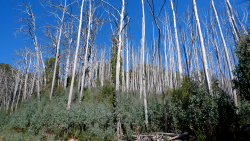 The 2009 bushfires killed extensive areas of Alpine and Mountain Ash forests. Ash forests are susceptible to fire and are usually killed. Their self-regeneration depends on natural seedfall, a process that proceeded very well following the 2009 bushfires. For areas already identified and approved for harvesting, VicForests has a two year window within which dead, standing Ash can be salvage harvested for community and sustainability benefits. But what happens to the natural regeneration?
The 2009 bushfires killed extensive areas of Alpine and Mountain Ash forests. Ash forests are susceptible to fire and are usually killed. Their self-regeneration depends on natural seedfall, a process that proceeded very well following the 2009 bushfires. For areas already identified and approved for harvesting, VicForests has a two year window within which dead, standing Ash can be salvage harvested for community and sustainability benefits. But what happens to the natural regeneration?
Forest Solutions has provided guidance to VicForests and reviewed an existing "Post Wildfire Salvage" Instruction to maximise the protection of regrowth during salvage operations. Routine harvesting techniques can be adapted and varied to assist this protection. The guideline links strongly with DSE's Native Forest Silviculture Guideline No. 17 - Forest Recovery After Bushfire, providing a strategy for regrowth management.
If regrowth is too severely damaged, the Instruction also provides guidance for the regeneration of salvage-harvested areas; a process that Forest Solutions continues to assist and develop.
17/07/2009 – Forest Solutions influences seed management |
  
|
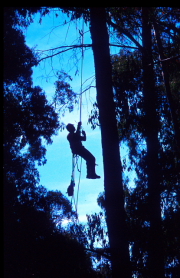 Forest Solutions has identified that the decade-long drought in SE Australia may have significantly reduced flowering frequency in eucalypts, producing periodic shortages in seed availability. Seed is critical for the continuance of Ash forests following disturbance - either as natural seedfall or artificially sown by forestry organisations as part of a silvicultural strategy. This shortage of seed is particularly serious given the current high frequency of severe bushfires in Victoria.
Forest Solutions has identified that the decade-long drought in SE Australia may have significantly reduced flowering frequency in eucalypts, producing periodic shortages in seed availability. Seed is critical for the continuance of Ash forests following disturbance - either as natural seedfall or artificially sown by forestry organisations as part of a silvicultural strategy. This shortage of seed is particularly serious given the current high frequency of severe bushfires in Victoria.
DSE commissioned Professor Ian Ferguson (Forest and Ecosystem Science, University of Melbourne) to undertake a review and economic analysis of predicted seed shortages and the implications for seed collection and management. Forest Solutions contributed to that review with guidance regarding the flowering capacity and performance of Ash forests in Victoria. One of Prof Ferguson's reports on this topic was published in December 2009 in Australian Forestry Volume 72: 195-205.
Page 1 of 2
 News
News